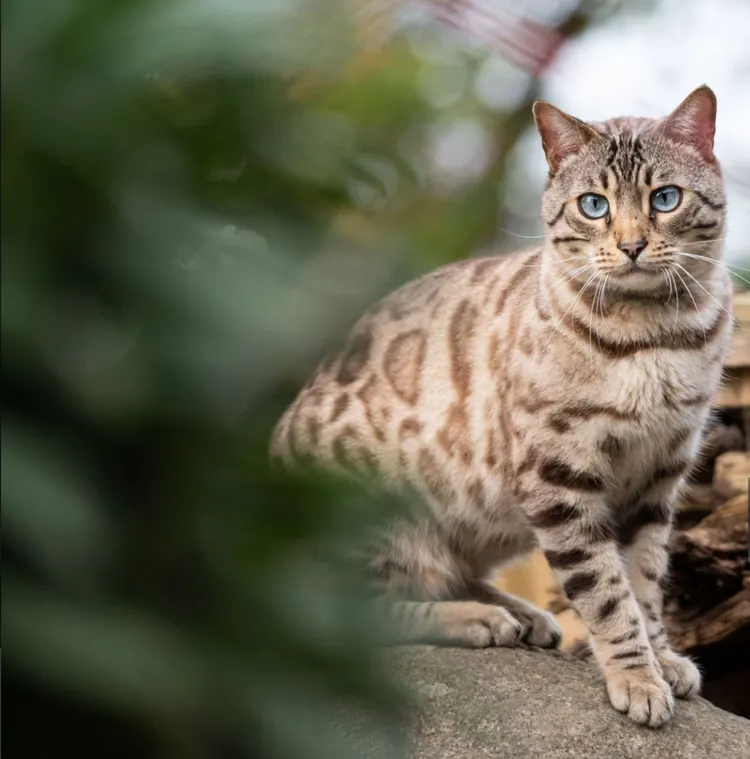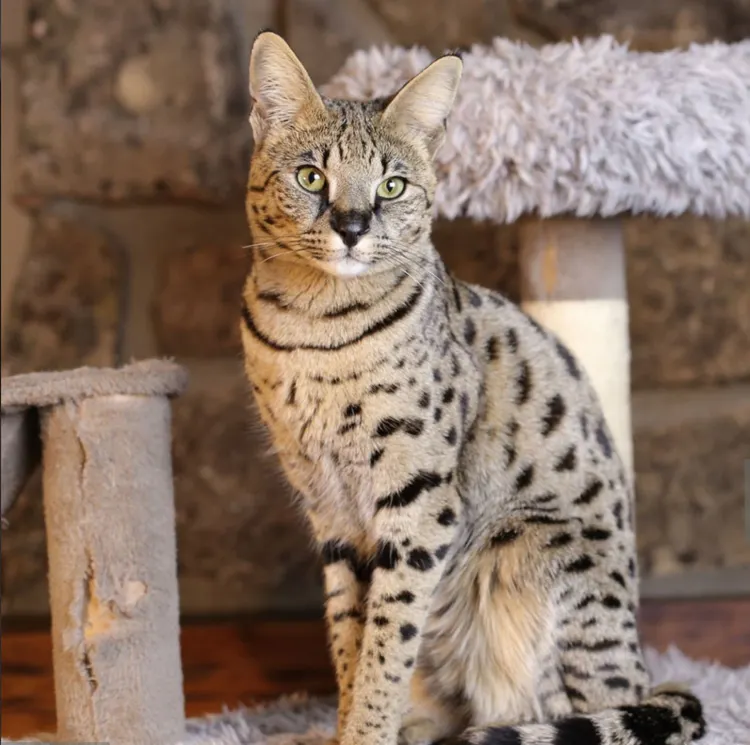Imagine having a wild-looking, exotic cat with the personality of a loyal dog lounging in your living room. That’s what life with a full-grown Savannah cat feels like! These remarkable felines, a cross between a domestic cat and a serval (a wild African cat), are becoming increasingly popular for their striking appearance and unique temperament. But before you get swept away by their charm, let’s dive into what living with a full-grown Savannah cat really looks like and how to adopt one in an eco-friendly, sustainable way. Spoiler: It’s not all fun and games, but it can be incredibly rewarding!
What Is a Full-Grown Savannah Cat?
Savannah cats are well-known for their wild heritage and majestic appearance. When fully grown, they boast a large, muscular build, tall stature, and a short, spotted coat that resembles their wild ancestors. While the average domestic cat weighs about 10 pounds, a full-grown Savannah cat can weigh anywhere between 15 to 30 pounds, depending on their generation (more on that later).
Their long legs, large ears, and bold patterns make them look like they’ve walked straight out of the African savannah, but they still maintain the loyalty and affection of a domestic house cat. Their energy, intelligence, and adventurous nature mean they require lots of stimulation and attention, making them more akin to a dog in temperament than a traditional cat.
The Different Generations of Savannah Cats
Savannah cats come in different generations, which indicate how far removed they are from their wild serval ancestors. These generations are labeled F1 through F5, with F1 being the closest to the serval and F5 being more domesticated. Here’s a quick breakdown:
- F1 Savannahs: These cats are 50% serval and 50% domestic cat. They’re the largest, most expensive, and tend to have more wild instincts. A full-grown F1 Savannah cat can weigh up to 30 pounds and stand around 17 inches tall.
- F2 to F5 Savannahs: As you move further from the serval ancestor, the wild traits start to diminish, and the size tends to decrease slightly. These cats are still large and maintain the exotic look but are usually more manageable in temperament.
The further you get from the F1 generation, the more domesticated the cat becomes, making F3 to F5 generations more suitable for first-time Savannah owners.
Eco-Friendly Adoption: A Sustainable Approach
Adopting a Savannah cat means bringing a part-wild, part-domestic animal into your home, so it’s essential to approach this responsibly and sustainably.
1. Research Ethical Breeders
When looking for a Savannah cat, make sure to choose a breeder who prioritizes the health and well-being of their animals. Ethical breeders will:
- Limit the number of litters they produce to avoid overbreeding.
- Provide proper healthcare and living conditions for their cats.
- Follow responsible breeding practices, including genetic testing to prevent health issues.
Look for breeders who are members of organizations like The International Cat Association (TICA), which ensures breeders meet certain standards of care.
2. Adopt, Don’t Shop (When Possible)
If you can, consider adopting a Savannah cat from a shelter or rescue group rather than buying from a breeder. Many people surrender their Savannahs because they’re unprepared for the demands of such an energetic breed. Adopting a rescue cat gives them a second chance at a happy life and reduces the demand for breeding, which is better for the environment.
3. Use Eco-Friendly Cat Supplies
Savannah cats need lots of toys, scratching posts, and other stimulation to keep them entertained, so opt for sustainable and eco-friendly products. Here’s how:
- Biodegradable cat litter: Avoid clay-based litter, which harms the environment. Instead, choose biodegradable alternatives made from pine, corn, or recycled paper.
- Eco-friendly toys: Since Savannah cats love to play, look for toys made from natural materials like hemp, wool, or sustainably sourced wood. These materials are better for the planet and safer for your pet.
- Sustainable food: Choose cat food made from sustainable, ethically sourced ingredients. Brands that focus on minimizing their carbon footprint by using organic and responsibly sourced proteins can help reduce the environmental impact of feeding your Savannah.

Advantages of Owning a Full-Grown Savannah Cat
When you bring a full-grown Savannah cat into your home, you’re signing up for a highly interactive and engaging pet. Here are some benefits you can expect:
1. Loyalty and Intelligence
Savannah cats are known for their dog-like loyalty. Many owners report that their Savannahs follow them from room to room, just like a canine companion. They can even be trained to walk on a leash and play fetch. Their intelligence means they can learn tricks, open doors, and even play puzzle games.
2. Exotic Look
One of the most significant draws of the Savannah cat is its stunning, exotic appearance. With its wild markings, long legs, and large ears, it’s hard to find another domestic cat that looks as unique as a Savannah.
3. Low-Allergen Coat
For allergy sufferers, Savannah cats may be a great option. Their short, dense coat produces fewer allergens compared to other breeds, although they aren’t entirely hypoallergenic. If you have mild cat allergies, a Savannah might be a good fit.
The Challenges of Owning a Full-Grown Savannah Cat
Savannah cats are beautiful and loyal, but they’re not without their challenges. Here’s what you need to be prepared for:
1. High Energy Levels
Savannahs, especially when full grown, are high-energy cats. They need lots of exercise and mental stimulation, or they’ll find their own ways to entertain themselves—often at your furniture’s expense. Be prepared for daily play sessions, lots of vertical space (they love to climb), and plenty of toys to keep them occupied.
2. Dietary Requirements
These cats need a high-protein diet to match their energy levels. This can get expensive, especially if you opt for sustainably sourced or organic cat food. However, feeding your Savannah a balanced, high-quality diet is essential for their health and well-being.
3. Space Considerations
While Savannahs can adapt to apartment living, they do best in homes with plenty of room to roam. If you live in a small space, you’ll need to make sure they have enough vertical climbing areas and toys to burn off their energy.

Caring for a Full-Grown Savannah Cat Sustainably
Owning a Savannah cat comes with its responsibilities, but you can do so in a way that minimizes your environmental impact. Here are some sustainable practices to follow:
1. Minimize Waste
Choose eco-friendly products for your cat, including biodegradable litter, natural grooming products, and recyclable food containers. Avoid single-use plastics whenever possible, and consider making DIY cat toys from upcycled materials.
2. Adopt Sustainable Feeding Practices
Buying in bulk reduces packaging waste, and choosing high-quality, ethically sourced food reduces the environmental impact of your cat’s diet. Look for brands that focus on sustainability and consider feeding your Savannah a raw or partially raw diet, which mimics their natural eating habits.
3. Eco-Friendly Cleaning Products
Savannahs are prone to making messes, thanks to their playful nature. When cleaning up after your pet, opt for eco-friendly, non-toxic cleaning products. These are better for the environment and safer for your pet.
Conclusion: Is a Savannah Cat Right for You?
Savannah cats offer the best of both worlds—a wild, exotic appearance paired with the loyalty and companionship of a domestic pet. However, they come with their own set of challenges, including high energy levels and dietary needs. If you’re prepared to meet their demands and want to adopt in an eco-friendly way, a Savannah cat could make an excellent, adventurous addition to your home.
Want to learn more about how to care for your exotic pets in a sustainable way? Join our newsletter for tips, tricks, and eco-friendly hacks to keep your furry friends happy—while saving the planet! 🌍



